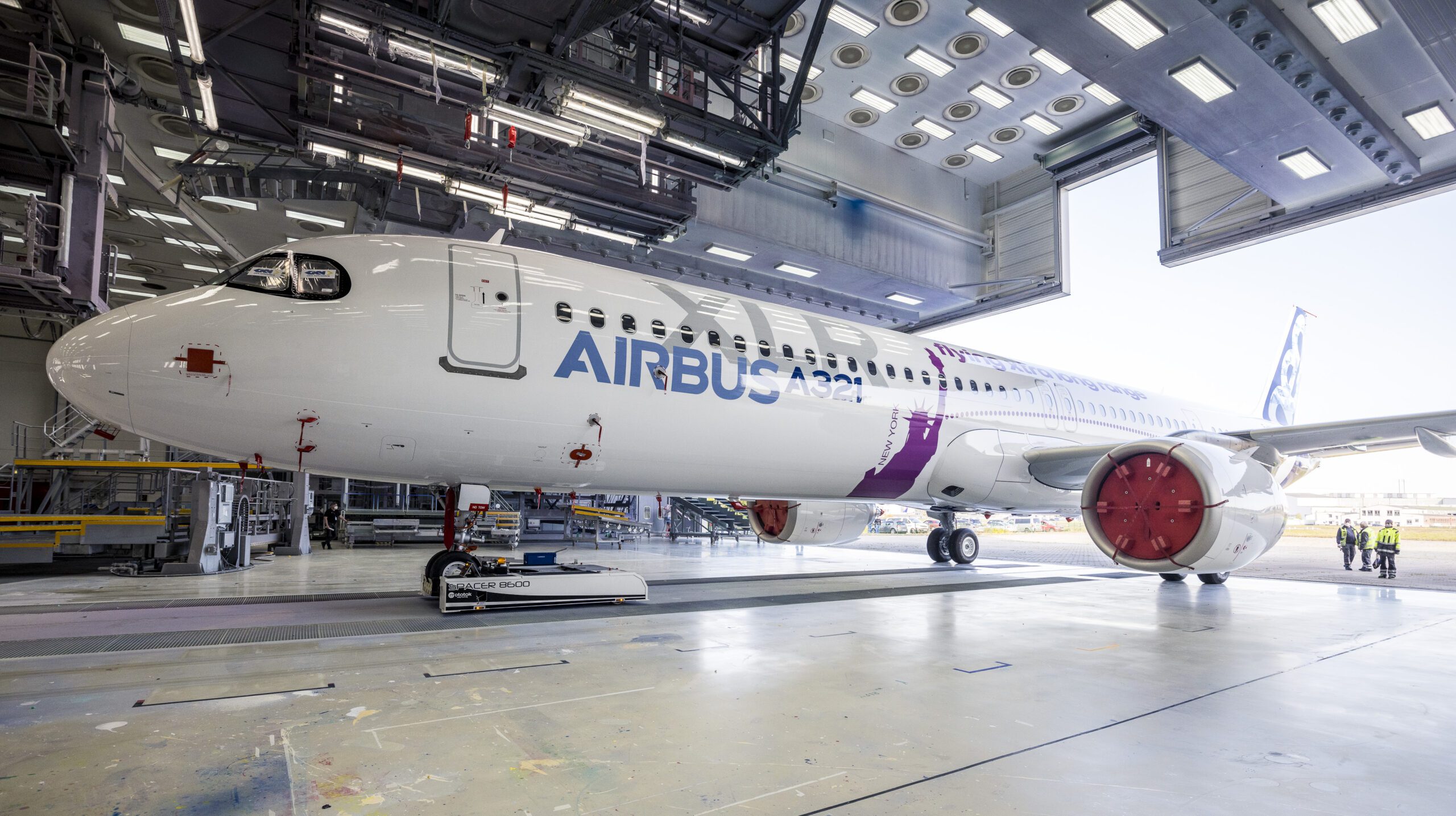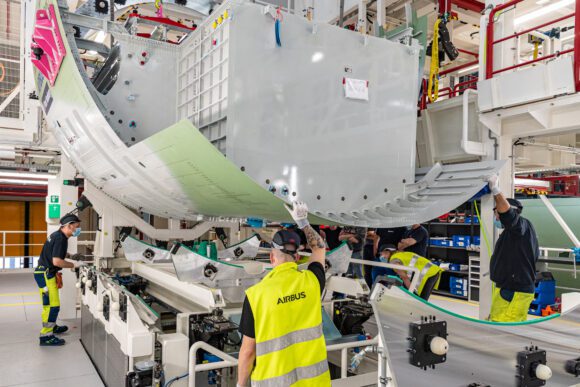
MSN11000 A321XLR Paint Rollout scaled
UPDATE – Entry into service of the Airbus A321XLR has slipped by a couple of months from late 2023 to early 2024. The delay is necessary to meet certification requirements, Airbus says in the release of its Q1 results. The airframer also confirmed that it will increase the production rate of the A320neo family to 75 in 2025. First delivery Airbus A321XLR slips to early 2024.
The slip in the XLR schedule shouldn’t be too worrying if it remains limited to just a few months. “We are in discussions with our customers to minimize the effects. We are really trying to stay on track and work hard to mitigate the effects for our customers”, said CEO Guillaume Faury. “When it comes to compensation for customers, we need to negotiate customer by customer and I can not share more. It (the delay) will not change the program as such.”
The most significant difference between the XLR compared to the A321neo and A321LR is the Rear Center Tank (RCT) which gives the XLR its 4.700nm/8.700km range. The position of the tank is subject to special attention from the regulators, especially after Boeing expressed concerns about the fire protection of the tank, which is right under the cabin. EASA stated that it will likely require extra measures to guarantee safety of the tank in the event of a fire. This could include additional insulation that would increase the weight of the XLR, potentially affecting its unique selling point – its range.
The Rear Center Tank, seen here on the very first A321XLR, is subject to further regulatory approval. (Airbus)
Faury said during today’s media and investor calls that it is not appropriate to specify what is causing the delay or what the European regulator EASA or FAA is requesting, except that it needs a bit more time to demonstrate the design to the regulators. Nor was he willing to say if the range of the XLR will be affected if regulators would make any requirements. Airbus said earlier it is confident that the RCT fully complies with safety. Airbus rolled out the first A321XLR in full livery from the paint shop in Hamburg earlier this week. The first flight is scheduled before the end of the current second quarter. The test campaign will include three aircraft.
Green light for rate 75 on the A32neo family from 2025
As the first delivery of the Airbus A321XLR slips to early 2024, Faury confirmed that Airbus will ramp up the rate of the A320neo-family to 75 per month from 2025. This is up from the current 43 per month and 65 that is planned from mid-2023. This follows the analysis of global customer demand and an assessment of the industry is ready for the higher rates. Faury said in January that a decision on a rate of seventy aircraft per month from 2024 was to be expected before this summer. Since then, Airbus has worked with suppliers and partners on confirming the higher rate. Last week, Safran and MTU (which supplies Pratt & Whitney) said they were ready for the higher rates. Airbus is comfortable enough to ramp up, given that the industry is coming out of the Covid crisis, said Faury. Between rate 65 in 2023 and 75 in 2025, there is time to adjust the schedule progressively and the supply chain, but Airbus has got positive signs that suppliers can manage the higher rates. Chief Financial Officer Dominik Asam added that higher rates will improve program margins.
The ramp-up of the A321neo production will be accommodated across all production facilities, so Hamburg, Toulouse (where the former A380 final assembly line is reconfigured), Tianjin (China), and Mobile (Alabama). Airbus said in December that the XLR would be produced not just in Hamburg but elsewhere too.
As previously announced, A330 production will go to almost two aircraft per month by the end of this year and the A350 to six in early 2023.
Looking at the financials, Airbus Group reported a €1.219 billion net profit, up from €362 million in the first quarter of last year. It produced an Adjusted EBIT of €1.263 billion compared to €694 million in Q1 last year. This includes €-11 million in A380-related costs and €-13 million benefit in other costs, plus €+190 million in pre-delivery payment mismatch and balance sheet evaluation costs. Reported EBIT was €1.429 billion compared to €462 million. Group revenues ended at €12 billion flat versus €10.460 billion in 2021.
Commercial aircraft revenues up to 8.5 billion
Commercial Aircraft reported an EBIT Reported of €1.242 billion compared to €343 million, EBIT Adjusted of €1.065 billion versus €533 million. Revenues were €8.541 billion versus €7.272 billion. Airbus delivered 140 aircraft in Q1 compared to 125 in the same period last year. Deliveries exclude two A350s for Aeroflot that were officially transferred to the airline in December but were scheduled for actual delivery later. The sanctions on Russia following the invasion of Ukraine now prevent the delivery to Aeroflot. The aircraft are now in storage in Toulouse with engines removed. Net order intake for the quarter was 83 compared to -61 last year.
Concerns over deliveries to China
Sanctions on Russia impacted the Q1 result by €0.2 million. Airbus’ direct exposure is for the thirteen A350-900s on order from Aeroflot, but it didn’t mention orders by lessors that planned to place aircraft with Russian customers. For example, in Hamburg, three A321neo’s are in preparation for S7 Siberia Airlines but are now in inventory. Apart from aircraft for Russia, Airbus has around 100 aircraft in inventory because a part is missing following supply chain problems.
Another concern for Airbus is China. With continued Covid restrictions seriously having reduced air travel to some twenty to thirty percent of pre-Covid levels, Faury said that in the short term, this might impact the (financial) ability of some customers to take delivery of new aircraft. It is a risk, but how this works out during the year is unclear.
Despite challenges, Airbus upholds its previous guidance for 720 aircraft deliveries this year, EBIT Adjusted of €5.5 billion, and free cash flow before mergers and acquisitions and customer financing of €3.5 billion. This depends on no further disruptions to the world economy and internal operations. China, Russia, and supply chain issues make meeting the targets more difficult. Effects of higher energy prices are covered for this year, but inflation persists for long, it could be a problem for some suppliers and could require negotiations with suppliers. Airbus is seeing inflation of labor costs, with a new wage agreement with higher salaries recently concluded in the UK. The challenge is to conclude agreements that make sense for employees and Airbus, said Faury.
Airbus ended the quarter with €22.8 billion in gross cash and €7.7 billion in net cash, with €28.8 billion in liquidity.
Views: 32




